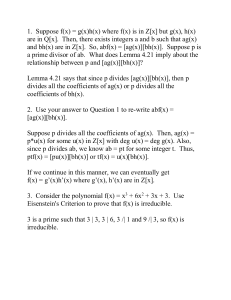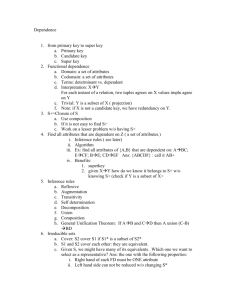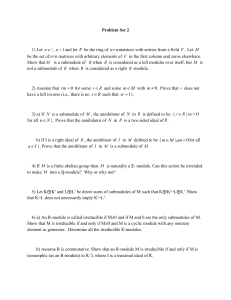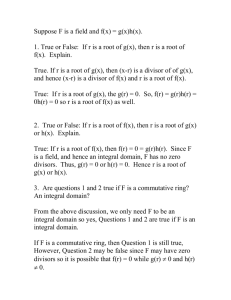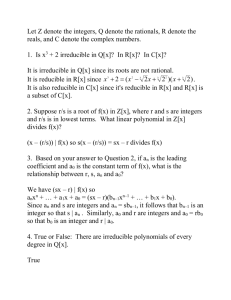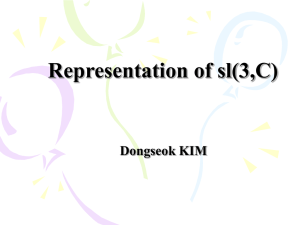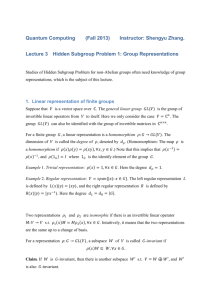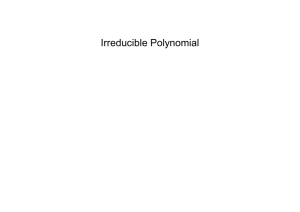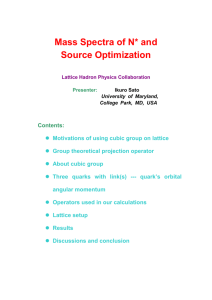Program-Irrep
advertisement
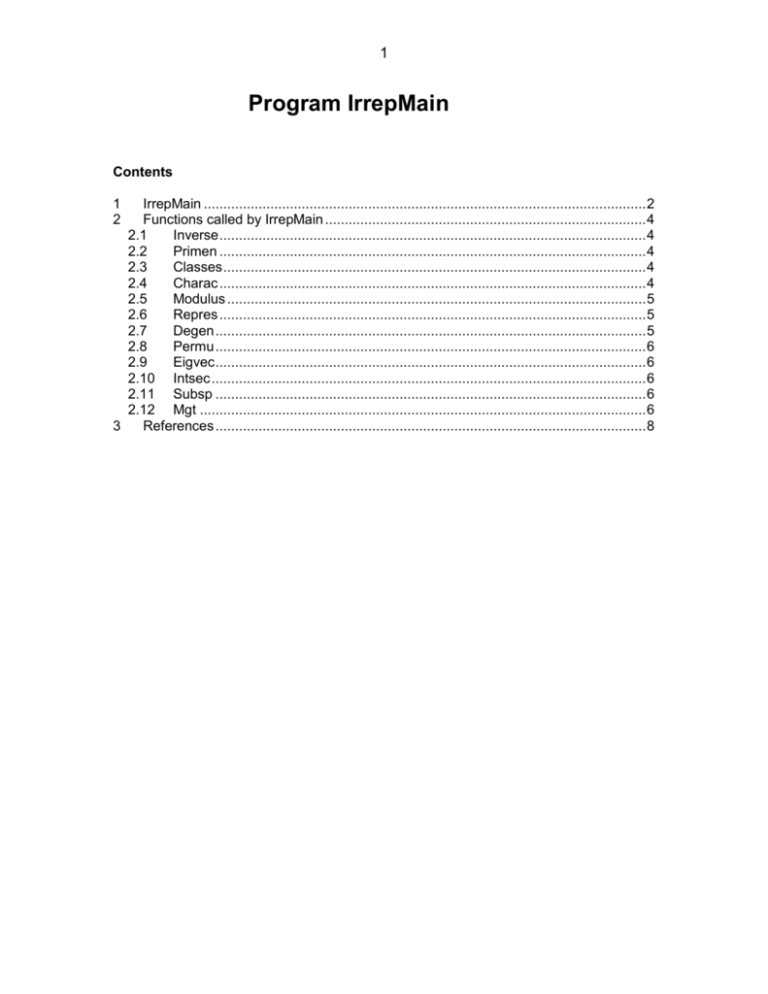
1 Program IrrepMain Contents 1 2 IrrepMain ................................................................................................................. 2 Functions called by IrrepMain .................................................................................. 4 2.1 Inverse ............................................................................................................. 4 2.2 Primen ............................................................................................................. 4 2.3 Classes ............................................................................................................ 4 2.4 Charac ............................................................................................................. 4 2.5 Modulus ........................................................................................................... 5 2.6 Repres ............................................................................................................. 5 2.7 Degen .............................................................................................................. 5 2.8 Permu .............................................................................................................. 6 2.9 Eigvec .............................................................................................................. 6 2.10 Intsec ............................................................................................................... 6 2.11 Subsp .............................................................................................................. 6 2.12 Mgt .................................................................................................................. 6 3 References .............................................................................................................. 8 2 Program Irrep Authors Per-Olof Jansson, Esko Blokker and Stig Flodmark Version 1.0, 2006-08-18 IrrepMain is a Matlab-version of the previous Irrep, written in FORTRAN. The algorithm has been extended to handle irreducible representations with no non-degenerate eigenvalue, e.g. the fourth order irreducible representation of the product group C4vxC4v, according to ref. [1] and [2]. 1 IrrepMain The script IrrepMain calculates the irreducible characters and the irreducible representations of an algebraic group. The group is input as a square matrix, multab. The group order, G, is read. The irreducible characters are calculated; calling several functions by IrrepMain. The functions called are pictured in figure 1. You will have to update the IrrepMain statements: load xx.dat; G = xx; where xx shall be name of your input file, containing the group order and load yy.dat; multab = yy; where yy shall be name of your file, containing the GxG multiplication table of your group. IrrepMain inverse primen eigvec permu intsec mgt genera classes charac repres degen modulus permu eigvec permu intsec subsp Figure 1: Functions called by IrrepMain 3 Table 1: Conventions for input data steer I If steer(I) ~= 0 1 The multiplication table of the group will be printed. Calculate for this group the irreducible representation matrices (not only the irreducible characters). Print the inverse group elements (function inverse) Print the number of generators nmberg, the group indices of the generators ngen(I), the map map(1:G,1:2) by which each group element can be constructed as a product of generators (function genera). Print loop structure (function permu) of the group element with a unique eigenvalue (function repres). Print the number of classes and the group elements in each class (function classes). Print the table of primes (function primen). Print the exponent ex of the group, the prime P used in the calculations of the present group, Zprim, the used primitive root of unity modulus P, the characters as sums of roots of unity (function charac). Print the dimensions lj(1:ncl) of the irreducible representations and the irreducible characters ch(1:ncl,1:ncl) (function charac). Print the one-dimensional group representation (function repres). Print the irreducible representations of the group of dimension higher than one (function repres). Not used. In the input, steer(11) should always be “true”. This means that no error has occurred so far for this group. The program may change the value of the steer(11) if it detects an error. No effect. These parameters can be neglected or used for own purposes. 2 3 4 5 6 7 8 9 10 11 12-20 If steer(I) == 0 No print Calculate only the irreducible characters. No print. No print. No print. No print. No print No print. No print. No print. Stop execution for the present group and continue with the next group. No effect. 4 2 Functions called by IrrepMain 2.1 Inverse The function inverse calculates the inverse of each group element and stores the inverses in inverse(1:G). inverse(I) is the inverse group element of element I. 2.2 Primen Function primen calculates one hundred prime numbers and stores these numbers in primen(1:100). The algorithm of Euclides is used in the calculation. Genera A set of generating elements of the group is calculated and stored in ngen(1:nmberg), where nmberg is the number of generating elements of the group. map(L,2) is zero if L is a generating element of the group. If map(L,2) is not equal to zero, map(L,1)*map(L,2) equals group element L. 2.3 Classes The group elements are collected into the different conjugate classes of the group. The group elements of the ncl classes are ordered in classl(1:G), such that classl(nfirst(I)) contains the first element in class I and classl(nfirst(I)+h(I)-1) contains the last element of class number I. nfirst(I) is the index of the first group element of class I in classl(1:G). h(I) is the order of the Ith class. 2.4 Charac The irreducible characters of the group are calculated according to Dixon’s method, see ref [3]. The class index of each group element is calculated and stored as cind(N) = I if group element N belongs to class I. The order norder(1:ncl), and the powers npow(I,K), of the elements in each class I are found. That is, the index of the class to which group element QK belongs, if Q belongs to class I. An exponent ex is found as the least common multiple of the orders norder(1:ncl) using the method of Euclides. A conjugate class whose elements have the lowest possible degeneracy is registered for each irreducible representation, in case there are no non-degenerate eigenvalues. 5 2.5 Modulus Function modulus calculates an integer I modulus an integer P and stores the resulting integer J, using the relation J = modulus(I,P). 2.6 Repres Function repres calculates the irreducible representations of the group elements in case there is at least one non-degenerate eigenvalue for at least one group element. The calculation starts with determining the loop structure of the group elements using function permu. In case all eigenvalues for all group elements are degenerate, function degen is called. An eigenvector to group element IN with the non-degenerate eigenvalue lab is calculated in the regular representation. This eigenvector is projected on the Jth irreducible subspace using the projection operator Sj. The resulting vector is stored in fi(1:G,1). fi(1:G,1) is operated on, using group elements other than powers of IN in order to create an orthonormal set of LJ1 vectors fi(1:G,1:LJ1). The regular representation of each generator of the group is transformed to the irreducible representation using the orthonormal set fi(1:G,1:LJ1). The irreducible representation of each group element is calculated by multiplying the irreducible representations of the appropriate generators. For one-dimensional irreps, the representations are obvious from the corresponding characters. 2.7 Degen In case there is no non-degenerate eigenvalue for any group element in the irreducible representation, function repres calls on function degen. The eigenvectors of group element IN, corresponding to eigenvalue lab in the regular representation are calculated using function eigvec. A set of mutual independent, commuting group elements to element IN is calculated and stored in ntry1(1:I3). Group elements from the set ntry1(1:I3) are successively taken and the eigenvectors corresponding to possible eigenvalues of the group element. Function intsec is called where the intersection of the subspaces spanned by the eigenvectors of IN and a group element belonging to the set ntry1(1:I3). If this intersection spanned by an orthonormal basis has the dimension LJ1, an othonormal basis which transforms irreducibly is formed by operating on the vectors with group elements not belonging to the loop of IN. A set of orthonormal columns is no formed, which will transform the regular representation to the irreducible one when returned to function repres. 6 2.8 Permu The loop of each group element, i.e. the successive powers of each group element is calculated. The loop length of each loop is stored in loopl(1:numl), where numl is the number of loops. The group elements are ordered in the vector lpstr(1:G) as successive loops. 2.9 Eigvec The eigenvectors of group element IN, with eigenvalue lab are calculated. Function permu is called to create eigenvectors, using the loop structure of element IN. The eigenvectors are projected on the Jth irreducible eigenspace, using the projection operator Sj. The resulting eigenvectors are orthonormalized to each other. If no eigenvector corresponding to eigenvalue lab is found, nvec is set equal to 0. 2.10 Intsec The intersection of the spaces spanned by fi(1:G,1:nvr2) and dfi(1:nvr1,1:G) in the sum of the two spaces ( fi dfi ) is found. The normals to the two space are calculated and stored in the vectors dfin(1:G,1:K5) and fin(1:K6,1:G). The intersection of fi and dfi is spanned by an orthonormal basis which is simultaneously orthogonal to the vectors dfin and fin. 2.11 Subsp In case the degeneracy is not split using group elements of the maximal abelian subgroup stored in kelem(1:nvct), but for dfi(1:nvr1,1:G) also constitute an invariant set of columns. Then it might be possible to remove the degeneracy, using this subspace of the irreducible space. The group elements except those stored in kelem(1:nvct) for which dfi(1:nvr1,1:G) constitute an invariant space are stored in ninv(1:N). The group elements stored in ninv(1:N) are diagonalized in the representation spanned by dfi(1:nvr1,1:G). If the corresponding eigenvalues are not fully degenerate the degeneracy is at least partly removed. If it is possible to fully remove the degeneracy within function subsp, the control is returned to function degen and then to function repres; otherwise a call is made to function mgt. 2.12 Mgt If the degeneracy is neither removed in function degen nor in function subsp, a call is made for function mgt. In mgt the degeneracy is split by forming a matrix subm(1:G,1:G,1:ntry(J1)), as a result of linear combination of matrix representatives of the group elements. We use the set of columns stored in dfi(1:nvr,1:G) to form a basis for a matrix representation which contains the irreducible representation dprim times. dprim is the residual degeneracy after executing functions degen and subsp. D is the 7 original degeneracy. This basis of columns is stored in fi(1:G,1:nvr). The regular representation is then transformed into a new one containing the irreducible one dprim times, where the degenerate eigenvalue lab of group element IN appears in the first D*dprim diagonal places. A block diagonal matrix is created by a linear combination of matrix representatives. This matrix is stored in subm(1:G,1:G,1:ntry(J1)). The submatrix made up from the first D*dprim-dimensional block is diagonalized and all the matrix representatives are transformed to the same basis. An eigencolumn of the L1*L1dimensional (L1=D*dprim) submatrix of subm(1:G,1:G,1:ntry(J1)) is used for creating an irreducible basis. The projection onto the irreducible space of the matrix representation is equivalent to the one used in repres. Note, subfunction mgt has not been fully tested, as no group has been found where mgt necessarily is executed. 8 3 References [1] S Flodmark and P-O Jansson, Lecture Notes in Physics 94, 73 (1979) [2] S Flodmark and P-O Jansson in “Proc. Of the 10th Int. Colloquium on GroupTheoretical Methods in Physics”, North-Holland Amsterdam, 485-492 (reprint from Physica 114A, Nos. 1-3) [3] J.D. Dixon, Numer. Math. 10, 446 (1967) [4] S Flodmark, J. Comp. Phys. 25, 314 (1977) [5] S Flodmark and E Blokker in “Group Theory and its Applications 2”, Acad. Press NY, 1971 [6] S Flodmark and E Blokker, Int. J. Quantum Chem. 1S, 703 (1967), 4, 463 (1971), 5, 569 (1971), 6, 925 (1972)
